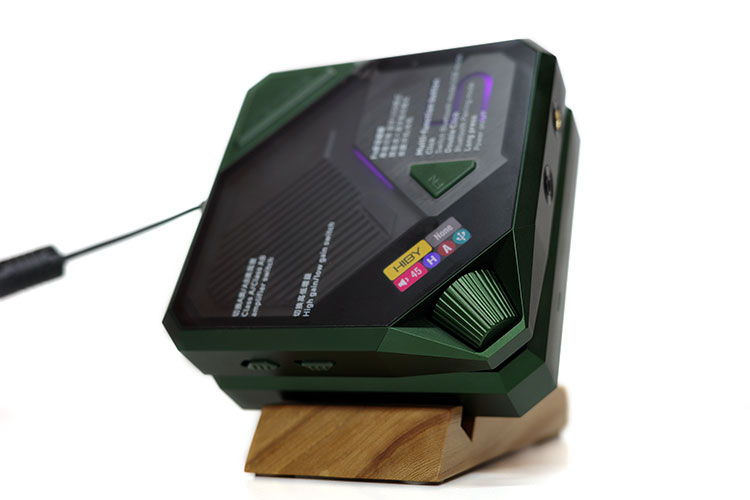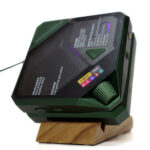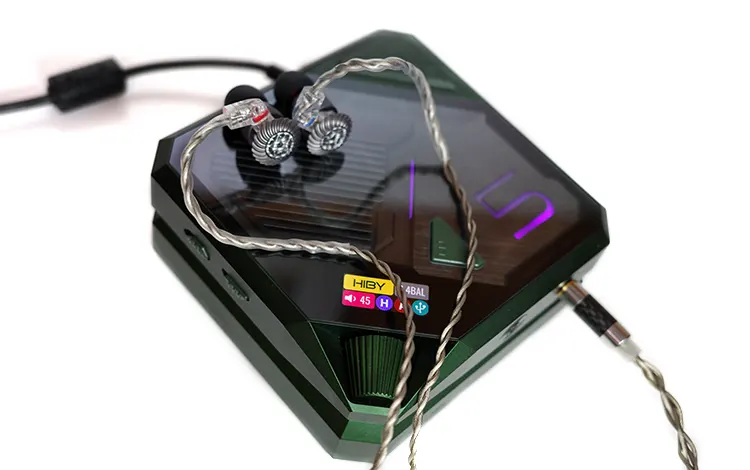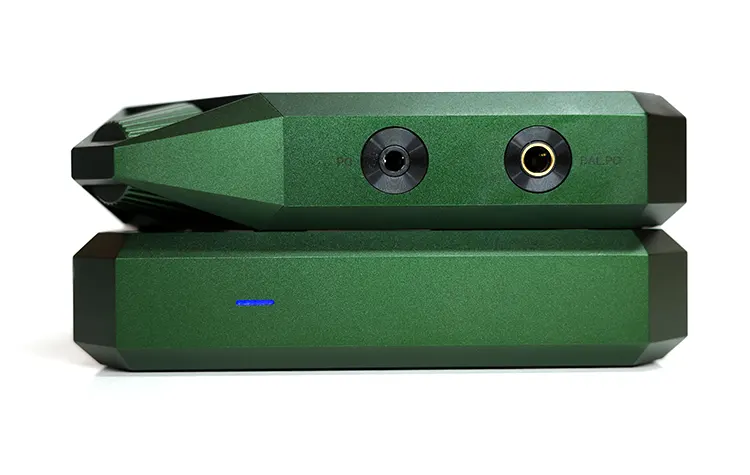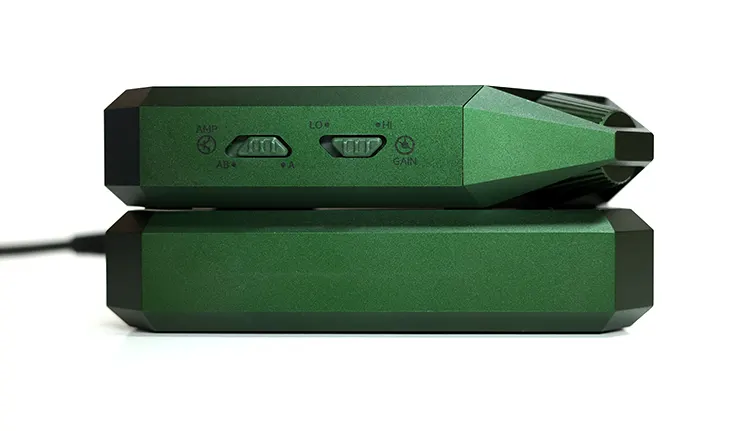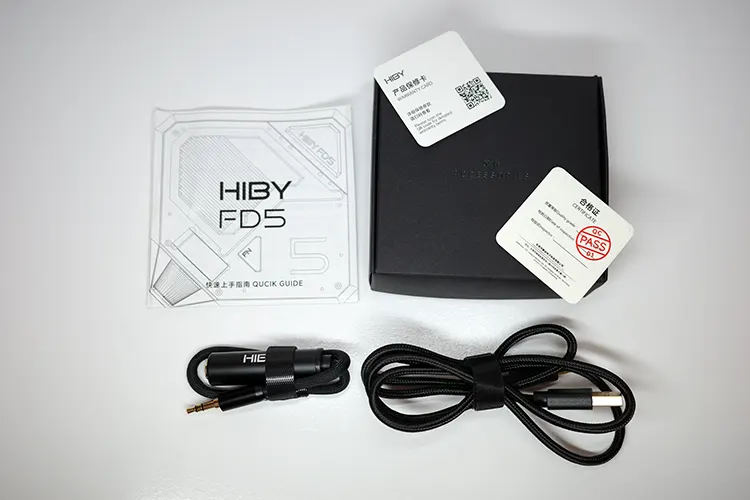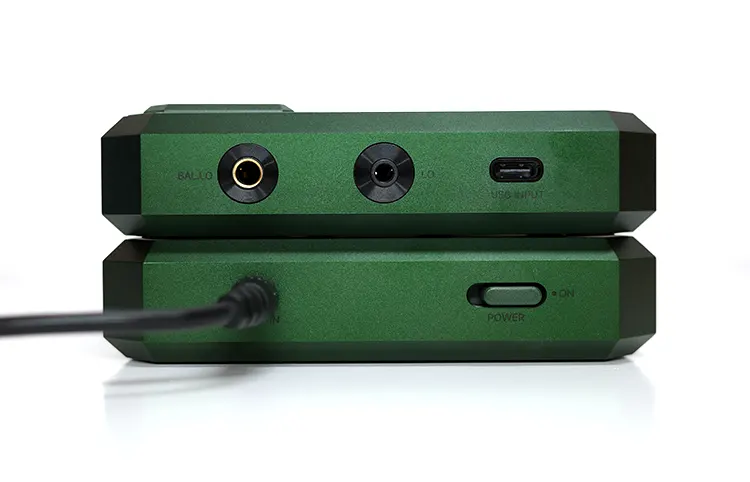In this feature, Lynn reviews the HiBy FD5, a compact desktop headphone amplifier and integrated DAC capable of DSD512 decoding and up to 1.5W of output power. It is priced at $429.
Disclaimer: This sample was sent to me in exchange for my honest opinion. Headfonics is an independent website with no affiliate links. I thank HiBy for their support.
You can click here to read more about the HiBy products previously reviewed on Headfonics.
Note, that this article follows our current scoring guidelines which you can read in more detail here.
The HiBy FD5 desktop headphone amplifier continues the company’s pattern of modernizing its lineup, with a “cyberpunk” design complete with a separate power source.
Having reviewed the R4 portable DAP, which follows the same design pattern; I took an interest in not only the look but of course performance of the FD5.
The looks alone can separate the unit from many run-of-the-mill desktop amplifiers, but the performance has to be up to snuff as well.
Competition in this realm lies with desktop models such as the Audalytic AH90 and FiiO’s K9 AKM, running both bigger and smaller, and more powerful or less powerful.
How does the HiBy stack up against such varied competition? That alone piqued my interest besides that cyberpunk look.

Features
The HiBy FD5 provides the listener with a Class A/AB amplifier capable of up to 1523mW balanced or 475mW single-ended on a 32 ohm load.
It uses a quad AKM4493 DAC chip array and dual femtosecond clocks of 45.158MHz & 49.152MHz capable of decoding PCM up to 32bit/768kHz, and native DSD512.
The separate discrete power module provides isolation to the music end of the FD5 amplifier, connected by a 20-pin snap connection.
HiBy clearly states the FD5 may only be connected with both pieces overlapping and discourages connecting one forward and one backward, creating a “cascade” effect. While this may look good, it will void the warranty.
Separate balanced and single-end line-level outputs allow for another option when connecting to your DAPs besides the usual USB-C. You also get wireless with a two-way BT operation, which can then be passed on to powered BT speakers if desired.
Design
There is no getting around the uniqueness of the FD5 in design principles. It is called “New Generation Audio Evangelism” by HiBy, which connotates a resurrection of previous design paired with excellent sonic characteristics.
Many companies separate their power unit from the amplification unit, isolating potential interference. The FD5 does so, with a Lego-like snapping one-way system for connecting the power base to the rest. There is also a heavy magnet, which helps guide you in the process of connection.
Each green metal square measures 115mm x 115mm x 52.7mm, making for a mostly cubic pairing when put together.
The FD5 power unit carries an on/off switch on one side and a blue operating light on the other. The top unit carries all of the functional buttons, along with an OLED small screen, which shows the decoding rate, headphone port used, volume level, gain, amplification class, and connection in use.
Just below that screen is a rotating volume knob, which decreases in radius as you move to the end, allowing the surface to be angular affording the user a better look at those functions.
A green triangular button acts as the function button for switching between BT, USB/LO options as well as a soft shutdown.
This last feature allows the on/off switch of the power unit to be kept on and the user can then use the green button for that purpose. A single click goes between each function while a double click once you are in BT mode sets the FD5 into BT pairing mode
A corresponding “5” is lit next to the function button in purple when using the FD5 wired, and blue for the BT connection.
I/O
The FD5 can connect with an assortment of options. The typical USB-C connection pairs well with your DAP or laptop, while the 3.5mm se and 4.4mm bal also carry LO options.
This allows for connecting to your DAP or another amplifier through a corresponding jack, as long as you use the USB-C input as your source.
The USB-C can connect to your powered speakers, laptop, or DAP as well as any home system which carries a corresponding USB-C input.
Controls
The FD5 once you put the two pieces together became a plug-n-play unit no matter the source. The side buttons carrying the Class A/AB switch and the low/high gain switch were of light resistance, making the switches easy to do once handed.
I also liked the rotary decreasing conical volume knob, which carried detents with each raising or lowering of the volume. One-click equals one volume number, which isn’t always the case.
The function button worked with an audible click, letting me know I had changed between USB and BT. The small OLED display gave good readability when something such as the decoding level or Class amplifier changed.
Packaging & Accessories
The FD5 comes in a glossy black square box with an angular lid that you remove completely.
Inside, you will find the power module, DAC/amp unit, and an accessories box in separate slots. That separation keeps each piece protected while giving the user a look at what you have.
Besides the QC card, warranty card, and owner’s manual; the accessories box contains the 12v power plug, a 2.0 USB Type A to Type C cable, and a 6.35mm to 3.5mm se adapter for use with your 6.35mm headphone cables.
Sound Impressions
My sound impressions of the HiBy FD5 were completed using the following devices over approximately four weeks.
Testing was completed with the Meze Audio 99 Classics with the ddHiFi BC150B 4.4 balanced cable, the Drop x Sennheiser HD6xx, the FiiO FT3 350Ω, and the Kennerton Magni V2. IEMs used were the Campfire Audio Supermoon and the Spirit Torino Twin Pulse Beryllium IEM.
Powered speakers were the Klipsch The Sixes.
Summary
The FD5 promotes a fluid vibrancy to the tone, with adequate soundstage. The midrange pushes a bit forward from both ends but did not feel lifted to me, lying pretty much dead center in relationship to the overall character.
There was plenty of power to drive moderately high-impedance headphones such as the Drop x Sennheiser HD6xx and the FiiO FT3.
Class A came off as warmer, with a rich bass line that held deeper than Class AB with a cleaner sound. Class AB was more detailed, with slightly better clarity to the notes, while being slightly thinner.
The differences between the two were minimal to me, and less than other amplifiers I have tried. The more sensitive the headphones or IEM, the better I could hear the differences, but they were still subtle.
Spatial awareness of the instruments was still quite good even with the forward midrange. I would not call this intimate, nor would I call it expansive. This would be a case of “just right.”
Timbre
The HiBy FD5 sits on the slightly warmer side of the fence but with good levels of detail retrieval.
Notes come across as slightly colored with maturity or smoothness, which is fairly typical of Class A. Class AB comes across as cleaner, and thinner but with better detail. Hence it has less coloration, but better resolution.
You can tell the impact the four AKM chips have on the sound characteristics of the FD5 whether it is on the PCM or DSD side. The richness and a warmer sound pervades the Class A tonality, without becoming too slow or methodical.
Not as punctuating or dynamic as Class AB when using the right IEM or headphones, the FD5 does carry a sense of urgency to the sound, without thinning notes. Just do not expect complete accuracy from Class A, which is by nature richer and warmer.
Class AB on the other hand presents the music with an accuracy to detail and clarity, which borders on euphonic. There is an ample amount of detail retrieval to the sound coming forth, but not so much that notes become thinner or brittle.
Note weight carries slight elongations in decay, giving a slight lingering effect, which acts to fill in the air between notes, almost like a Class A amplifier might. But with a succinct nature to the music which is amply detailed but not truncated.
I found myself switching between the two amplifier settings multiple times to gauge the effect. Some songs I preferred in Class A, while others were in Class AB. Having the ability to do that quickly adds to the positive sound aspect of the FD5, to me.
Staging & Dynamics
Class AB presented very good detail retrieval with a succinct quality (except for the slight decay) to the notes, which provided accuracy to the overall signature. I did find Class A more musical and more to my tastes, especially with the longer attack and decay brought on in typical Class A manner.
The resolution was tighter in Class AB, but not by much. The warmer Class A still provided good resolution and transient response but with more of an emotive effect than Class AB.
Accuracy (overall transient response) went the Class AB way, without becoming too thin or lacking emotion due to the note decay.
The soundstage was neither too grandiose nor too intimate, providing a mostly cubic response, with a bit better depth than height and width.
This fore/aft response allowed me to discern the placement of instruments on the stage, but I do wish for a bit wider soundstage.
Wireless Connectivity
The connection was straightforward to the HiBy R4, and within a few seconds, Tidal or Qobuz were streaming. There is no app accompanying the FD5.
The Bluetooth sound comes across as accurate and detailed without losing much clarity over wired usage. The UAT CODEC provided excellent vibrancy and depth to the notes, lending a rich signature that was enjoyed across all listening devices.
I detected no delay when playing YouTube videos or streaming a Football game from my iPhone 13 Pro Max to the FD5.
Wired Connectivity
USB-DAC
The connection using the USB-C out to either a laptop or DAP was seamless. I could easily switch to the FD5 on my MBP under sound settings, and Tidal recognized it instantly as well.
On the R4 though, I did have to use the USB Audio Pro app for any listening, whether that was from a memory card or streaming through Tidal or Qobuz. Both of those latter apps were natively found within USB Audio Pro.
Line Level Out
When using Line Level Out, you have the choice of either 3.5mm se or 4.4mm bal with which to connect to another source such as a headphone amplifier should you desire.
This can also be used for connection to powered speakers or an AUX slot on a two-channel system if that connection is available.
I used the 3.5mm single-ended LO for connecting to my Klipsch The Sixes powered speakers without issue, then ran the R4 through BT to the FD5 for seamless streaming.
Click on page 2 below for my recommended pairings and selected comparisons.

